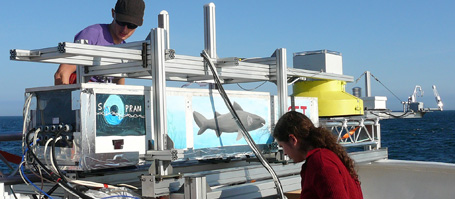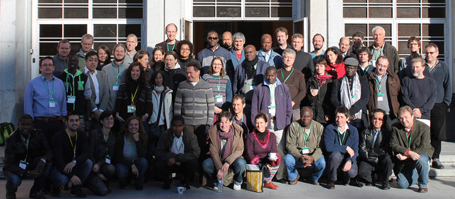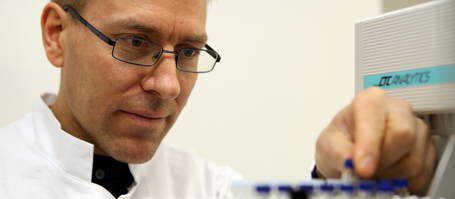Smoky chimneys from factories and power stations, emissions from boats, cars and trucks – we humans are still releasing carbon dioxide and other greenhouse gases into the atmosphere. There they are causing a rise in average temperature. Not all gases, however, stay in the atmosphere. The oceans for example, absorb up to a third of the carbon dioxide emitted into the atmosphere. On the one hand this is good, as the oceans are slowing the temperature rise. On the other hand, this process is worrying because it changes environmental conditions. Some organisms can handle this change better than others. In addition these changes might cause the oceans to not only absorb gases but also to release climate relevant gases such as nitrous oxide (laughing gas) and halogenated hydrocarbons.
“We need to understand the complex interplay between atmosphere and ocean with all its biological, physical and chemical aspects in order to predict the future development of climate on our planet” says marine chemist PD Dr. Hermann Bange from GEOMAR Helmholtz Centre for Ocean Research Kiel. He coordinates the collaborative research project SOPRAN financed by the BMBF, which has been studying the relationship between the ocean and the atmosphere on a wide, specialist basis since 2007. Now the project is beginning its third and final phase. Therefore the BMBF has approved a further 6 million Euros until 2016, of which 2.8 million will go to GEOMAR as the coordinating scientific institution.
Chemists, biologists, physicists and meteorologists deal for instance with how changes in the composition of the atmosphere, such as an increase in CO2 or dust concentration, will affect the ecosystem of the ocean close to the water’s surface. Other sub-projects of SOPRAN explore how the framework conditions that have been changed by the climate, influence the emission of climate relevant trace gases from the ocean into the atmosphere. They are also trying to determine how the material exchange mechanism works and at what rate.
In order to answer these questions, the SOPRAN scientists use a wide range of methods and techniques. Data and samples from the tropical Atlantic and the Pacific have been gathered during research expeditions and by autonomous measuring platforms. For the tropical Atlantic the researchers can use long-term monitoring data from the Cape Verde Ocean Observatory (CVOO) and the Cape Verde Atmospheric Observatory (CVAO).
SOPRAN scientists have also been active in cold waters. With Kiel‘s mesocosms off the coasts of Norway and Finland, they have studied how high CO2 values influence the emission of climate relevant gases. Model experiments in the Aeolotron, a unique wind-wave facility at the University of Heidelberg, supplement the measurements of the gas exchange taken on the open ocean. All results are integrated into a computer model which allows insight into global interdependencies.
“In the now beginning third phase, we want to merge and publish all the insights obtained” says Dr. Bange. In order to round off the overall picture, new expeditions and large scale experiments will be conducted. An experiment series with Kiel’s mesocosms is planned off the Canary Islands in 2014. “In this way we can make comparisons with previous studies in cold waters” adds the project coordinator.
It is already clear that SOPRAN has corrected many old views. “The importance of surface films for the material exchange between ocean and atmosphere has been greatly underestimated” explains Dr. Bange. Moreover SOPRAN researchers have found oxygen free whirls, which no one had expected. Dr. Bange is sure, “Thanks to SOPRAN we will be able to predict future developments of the interaction between the ocean and the atmosphere much more precisely.”
Backgroundinformation:
The acronym SOPRAN stands for “Surface Ocean Processes in the Anthropocene”. The project is financed by the Federal Ministry of Education and Research (BMBF). Phase I ran from November 2007 until January 2010, phase II from February 2010 until January 2013. The third phase is funded until January 2016 with 6 million Euros. Alongside GEOMAR other participating institutes are: Alfred Wegener Institute for Polar and Marine research (AWI), University of Hamburg, University of Bremen, University of Heidelberg, Institute for Baltic Sea Research in Warnemünde (IOW), Leibniz Institute for Tropospheric Research in Leipzig, Max Planck Institute for Chemistry in Mainz. SOPRAN is simultaneously the German contribution to the international program SOLAS (Surface Ocean Lower Atmosphere Study) which combines the work of 31 nations to better understand the processes at the intersection of atmosphere and ocean. The international SOLAS office also resides at GEOMAR in Kiel.
Links:
www.geomar.de GEOMAR Helmholtz Centre for Ocean Research Kiel
http://sopran.pangaea.de Project SOPRAN
www.solas-int.org International SOLAS Program
Images:
Download images available here www.geomar.de/n1135
Contact:
PD Dr. Hermann Bange (GEOMAR, FB2-Chemical Oceanography)
hbange@geomar.de
Jan Steffen (GEOMAR, Communication & Media),
Tel.: (+49) 0431 600-2811
jsteffen@geomar.de
…



